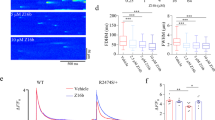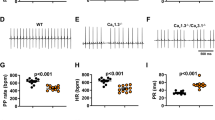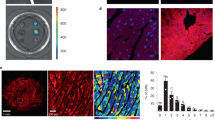Abstract
Catecholaminergic polymorphic ventricular tachycardia (CPVT) is a potentially lethal inherited arrhythmia syndrome in which drug therapy is often ineffective. We discovered that flecainide prevents arrhythmias in a mouse model of CPVT by inhibiting cardiac ryanodine receptor–mediated Ca2+ release and thereby directly targeting the underlying molecular defect. Flecainide completely prevented CPVT in two human subjects who had remained highly symptomatic on conventional drug therapy, indicating that this currently available drug is a promising mechanism-based therapy for CPVT.
This is a preview of subscription content, access via your institution
Access options
Subscribe to this journal
Receive 12 print issues and online access
$209.00 per year
only $17.42 per issue
Buy this article
- Purchase on Springer Link
- Instant access to full article PDF
Prices may be subject to local taxes which are calculated during checkout


Similar content being viewed by others
References
Leenhardt, A. et al. Circulation 91, 1512–1519 (1995).
Mohamed, U., Gollob, M.H., Gow, R.M. & Krahn, A.D. Heart Rhythm 3, 1486–1489 (2006).
Pizzale, S., Gollob, M.H., Gow, R. & Birnie, D.H. J. Cardiovasc. Electrophysiol. 9, 1319–1321 (2008).
Wilde, A.A. et al. N. Engl. J. Med. 358, 2024–2029 (2008).
Robinson, M., Park, J. & Raff, G. Heart Rhythm 4 Suppl, S100 (2007).
Priori, S.G. et al. Circulation 103, 196–200 (2001).
Lahat, H. et al. Am. J. Hum. Genet. 69, 1378–1384 (2001).
Jiang, D. et al. Proc. Natl. Acad. Sci. USA 101, 13062–13067 (2004).
di Barletta, M.R. et al. Circulation 114, 1012–1019 (2006).
Knollmann, B.C. et al. J. Clin. Invest. 116, 2510–2520 (2006).
Cerrone, M. et al. Circ. Res. 101, 1039–1048 (2007).
Venetucci, L.A., Trafford, A.W., Diaz, M.E., O'Neill, S.C. & Eisner, D.A. Circ. Res. 98, 1299–1305 (2006).
Gyorke, S., Lukyanenko, V. & Gyorke, I. J. Physiol. (Lond.) 500, 297–309 (1997).
Shoshan-Barmatz, V. & Zchut, S. J. Membr. Biol. 133, 171–181 (1993).
Marban, E., Robinson, S.W. & Wier, W.G. J. Clin. Invest. 78, 1185–1192 (1986).
Rosen, M.R. & Danilo, P. Jr. Circ. Res. 46, 117–124 (1980).
De Rosa, G. et al. Pediatr. Emerg. Care 20, 175–177 (2004).
Postma, A.V. et al. Circ. Res. 91, e21–e26 (2002).
Acknowledgements
We thank S. Huke and S. Kim for their assistance with the data analysis and the preparation of figures, P. Johnson for his assistance with the single-channel recording and N. Masalha and S.A. Clur for their assistance in patient care and management. This work was supported in part by the US National Institutes of Health grants HL88635 and HL71670 (to B.C.K.) and HL49989 (to D.M.R.), by the American Heart Association Established Investigator Award 0840071N (to B.C.K.), by the Australian Research Council grant DP0557780 (to D.R.L.), by an infrastructure grant from New South Wales Health through Hunter Medical Research Institute (to D.R.L.), by the Leducq Foundation grant 05CVD01 (to A.A.M.W. and D.M.R.) and by the Alberta Heart and Stroke Foundation Chair in Cardiovascular Medicine (to H.J.D.).
Author information
Authors and Affiliations
Contributions
H.W. and H.S.H. conducted and analyzed the in vivo mouse ECG experiments, N.C. and H.S.H. conducted and analyzed the isolated myocyte experiments, D.L. conducted and analyzed the RyR2 single-channel experiments, A.A.M.W. conducted and analyzed the human studies, S.S.D. analyzed the flecainide concentrations, D.E.R. and H.J.D. provided the ECG telemetry analysis software, H.W. and N.C. wrote the initial draft of the manuscript, D.M.R. edited the manuscript, and B.C.K. designed and supervised the overall project, and prepared the final manuscript and figures.
Corresponding author
Supplementary information
Supplementary Text and Figures
Supplementary Figs. 1–5 and Supplementary Methods (PDF 495 kb)
Rights and permissions
About this article
Cite this article
Watanabe, H., Chopra, N., Laver, D. et al. Flecainide prevents catecholaminergic polymorphic ventricular tachycardia in mice and humans. Nat Med 15, 380–383 (2009). https://doi.org/10.1038/nm.1942
Received:
Accepted:
Published:
Issue Date:
DOI: https://doi.org/10.1038/nm.1942
This article is cited by
-
Role of Ca2+ in healthy and pathologic cardiac function: from normal excitation–contraction coupling to mutations that cause inherited arrhythmia
Archives of Toxicology (2023)
-
Metabolically driven maturation of human-induced-pluripotent-stem-cell-derived cardiac microtissues on microfluidic chips
Nature Biomedical Engineering (2022)
-
Use of Flecainide in Stable Coronary Artery Disease: An Analysis of Its Safety in Both Nonobstructive and Obstructive Coronary Artery Disease
American Journal of Cardiovascular Drugs (2021)
-
Mechanisms underlying pathological Ca2+ handling in diseases of the heart
Pflügers Archiv - European Journal of Physiology (2021)
-
Inherited cardiac arrhythmias
Nature Reviews Disease Primers (2020)



